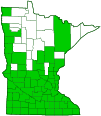prairie ironweed
(Vernonia fasciculata)
Conservation • Weed • Wetland • Description • Habitat • Ecology • Use • Distribution • Taxonomy
Description |
Prairie ironweed, also called smooth ironweed, is a 20″ to 55″ tall, erect, perennial forb that rises on a single stem or a clump of 2 or more stems from a stout, thickened rootstock. The stems are erect, round, light green or reddish-purple, and unbranched below the inflorescence. The are usually hairless but are sometimes minutely hairy near the top. The leaves are alternate, stalkless or on short leaf stalks, narrowly to broadly lance-shaped, 2″ to 7″ long, and ⅜″ to 1½″ wide. The leaf blades are tapered at the base and taper to a sharp point at the tip. The upper surface is green, smooth to the touch, and mostly hairless but may have fine short hairs near the margin. The lower surface is similar in color, hairless, and dotted with minute pitted glands. The glands appear as translucent dots when the leaf is held up to the sun or another light source. The margins are sharply toothed. The inflorescence is a dense, branched, 1½″ to 4″ wide, flat-topped cluster (cyme) of many flower heads at the end of the stem. The flower heads within the cyme are not grouped into secondary head-like clusters. The base of each flower head (involucre) is bell shaped, 3 ⁄16″ to ⅜″ long and ⅛″ to ¼″ high. The involucre is composed of 25 to 35 or more modified leaves (bracts) in 4 or 5 overlapping series. The involucral bracts (phyllaries) are ⅛″ to ¼″ long, and their tips are pressed closely to the involucre. They are green but usually tinged purplish along the midvein and toward the tip. They are mostly hairless on the back but sometimes have sparse, long, cobwebby hairs on the margins. The outer phyllaries are broad and scale-like. The inner ones are narrow. Each flower head has 10 to 26 disk florets and no ray florets. The disk florets are purple and ⅜″ to 7 ⁄16″ long. They are tube-shaped at the base then separated into 5 long, widely spreading lobes. The flowers have no noticeable scent. The fruit is a dry, brown, one-seeded, 1 ⁄16″ to ⅛″ long seed capsule (cypsela) with a modified calyx (pappus) is attached to one end. The pappus is in two series: an outer ring of 20 to 30 minute scales, and an inner tuft of 35 to 45 tan to brownish-purple, 3 ⁄16″ to ¼″ long hair-like bristles. |
Height |
20″ to 55″ |
Flower Color |
Reddish purple |
Similar Species |
|
Habitat |
Wet to moderate moisture. Prairies, meadows, pastures, marshes. Full sun. |
Ecology |
Flowering |
July to September |
Pests and Diseases |
|
Use |
|
Distribution |
||
|
Sources Biodiversity occurrence data published by: Minnesota Biodiversity Atlas (accessed through the Minnesota Biodiversity Atlas Portal, bellatlas.umn.edu, 7/19/2025). |
|
| 7/19/2025 | ||
Nativity |
||
Native |
||
Occurrence |
||
Common |
||
Taxonomy |
|
Kingdom |
|
Division |
Tracheophyta (Vascular Plants) |
Subdivision |
Spermatophytina (Seed Plants) |
Class |
|
Order |
Asterales (Sunflowers, Bellflowers, Fanflowers, and Allies) |
Family |
Asteraceae (Sunflowers, Daisies, Asters, and Allies) |
Subfamily |
Vernonioideae |
Tribe |
Vernonieae |
Subtribe |
Vernoniinae |
Genus |
Vernonia (ironweeds) |
Subfamily |
|
Subordinate Taxa |
|
Some sources recongize a western subspecies Vernonia fasciculata ssp. corymbosa or variety Vernonia fasciculata var. corymbosa, including Manual of Vascular Plants (Gleason and Cronquist, 1992) (as Vernonia fasciculata var. nebraskensis), Steyermark’s Flora of Missouri (Yatskievievyck, 2006), USDA PLANTS, GBIF, NatureServe, and World Flora Online. Other sources do not recognize any subspecies or varieties, include GRIN, Flora of North America, ITIS, NCBI, Plants of the World Online, and The Global Compositae Database. |
|
Synonyms |
|
Cacalia corymbosa Cacalia fasciculata Plectreca corymbosa Serratula corymbosa Vernonia corymbosa Vernonia fasciculata ssp. corymbosa Vernonia fasciculata ssp. fasciculata Vernonia fasciculata var. corymbosa Vernonia fasciculata var. fasciculata Vernonia fasciculata var. nebraskensis Vernonia schweinitzii |
|
Common Names |
|
bunched ironweed common ironweed ironweed prairie ironweed smooth ironweed |
|
Visitor Photos |
||
Share your photo of this plant. |
||
This button not working for you? |
||
Dan W. Andree |
||
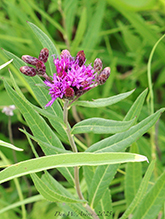 |
||
Wildflower |
||
|
||
| Interesting Wildflower |
|
|
MinnesotaSeasons.com Photos |
||
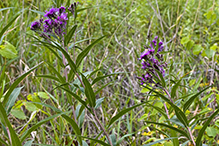 |
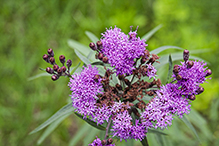 |
|
Plant |
Inflorescence |
|
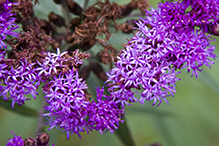 |
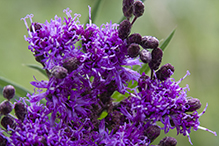 |
|
Inflorescence |
Inflorescence |
|
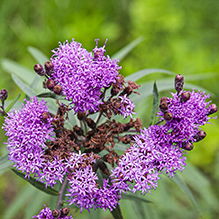 |
 |
|
Leaves |
||
|
||
|
||
Inflorescence |
|
|
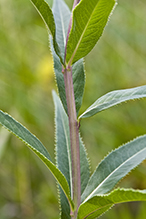 |
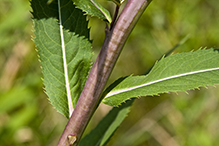 |
|
Stem |
||
|
||
|
||
Stem |
|

Slideshows |
|

Visitor Videos |
||
Share your video of this plant. |
||
This button not working for you? |
||
|
Other Videos |
||
Minnesota Native Plant - Bunched Ironweed (Vernonia Fasciculata) |
About
Published on Aug 11, 2013 Today's video is the Bunched Ironweed (Vernonia Fasciculata). This beautiful purple flower attracts butterflies and insects. A great plant near a pond or water feature. |
Ironweed (Vernonia fasciculata) |
About
Uploaded on Sep 2, 2011 http://www.prairiemoon.com This stately plant offers unusually brilliant purple flowers on top of 6-8' tall stems in rich soils. Ironweed works well as a tall backdrop garden plant and blooms between July and September. |

Visitor Sightings |
||
Report a sighting of this plant. |
||
This button not working for you? |
||
Dan W. Andree |
Location: Dalby WMA, Norman Co. Mn. |
 |
MinnesotaSeasons.com Sightings |
||

|
Created: 9/4/2005 Last Updated: © MinnesotaSeasons.com. All rights reserved. |
